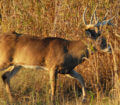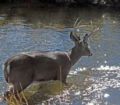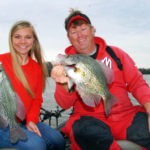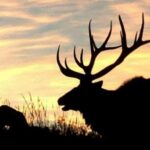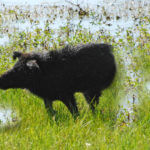Editor’s Note: Regardless of how-many decoys you put-out to lure-in ducks, if you place those decoys in ponds and potholes that ducks never frequent, they won’t lure-in any ducks. The same is true of deer attractants. Yes, their fragrances eventually may lure-in deer. However, if you put a deer attractant along the edges of trails that deer use every day, they don’t have to find the attractant. They’ll pass by it regularly. You’ll see more deer at your deer attractant sites next to trails than if you just put the attractant out in the middle of the woods where there’s no deer sign at all. To see the most deer and possibly the biggest deer quickly, put deer-attractant products where you know deer are traveling on trails. Several-different types of paths or trails are used by deer. Some are obvious, but many are inconspicuous. If you know what to look for and where to look, you can take a stand along these trails, place deer-attractant products nearby and drastically increase your ability to find and bag deer. Let’s determine how to locate various kinds of trails, how to hunt them and how you can use deer attractants to improve your chances for taking deer on those trails.
 Because terrain trails concentrate deer coming and going from two-different directions onto a very-narrow path, they can be highly productive for the deer hunter. A terrain trail often will be in a saddle between two mountains, because this saddle is the lowest place that crosses the mountain range. By taking a stand on either side of the mountain, the hunter has the best chance of taking a buck. If you place your stand in the middle of a saddle and spook deer, the animals may run back the way they’ve come and spook other deer that are coming up the trail. However, if you take a stand on either side of a saddle, if a buck does spook, he either may run to the left or to the right, instead of back-up the trail from where he’s come. Then you’ll have an opportunity to shoot at deer coming down the trail all day, even if you spook one or two animals. Therefore, when you put-out a deer attractant on either side of one of these terrain trails, make sure you put it 10- to 20-yards off the trail. The deer moving up and down the trail can smell it, but when you take the shot, the chances of them running back up the trail that they’ve just come down may not be as great.
Because terrain trails concentrate deer coming and going from two-different directions onto a very-narrow path, they can be highly productive for the deer hunter. A terrain trail often will be in a saddle between two mountains, because this saddle is the lowest place that crosses the mountain range. By taking a stand on either side of the mountain, the hunter has the best chance of taking a buck. If you place your stand in the middle of a saddle and spook deer, the animals may run back the way they’ve come and spook other deer that are coming up the trail. However, if you take a stand on either side of a saddle, if a buck does spook, he either may run to the left or to the right, instead of back-up the trail from where he’s come. Then you’ll have an opportunity to shoot at deer coming down the trail all day, even if you spook one or two animals. Therefore, when you put-out a deer attractant on either side of one of these terrain trails, make sure you put it 10- to 20-yards off the trail. The deer moving up and down the trail can smell it, but when you take the shot, the chances of them running back up the trail that they’ve just come down may not be as great.
Another type of terrain break that often will concentrate deer are benches in mountainous terrain. Oftentimes, a bench will go around a mountain that’s like a flat place right in the middle or near the top or the bottom of the mountain. You’ll often see these benches on reclaimed  strip-mined land, especially some of the older strip-mined properties. Another place to look for benches is where timber has been clear cut off the side of a mountain, because benches stop erosion and can be planted as cover for wildlife. Usually there will be at least one trail through the middle of the bench or on one side or the other of the bench. Also, benches provide two good stand sites, if you remember that the thermals (air movement) in mountainous terrain are usually up in the morning. Therefore, your best stand site will be above the bench, and your best entry point to the bench will be coming from the top of the mountain down. The thermals in the afternoon usually come from the top of the mountain down. So, your best stand site then will be just below the bench, and your best approach direction will be from the bottom of the bench up. For this reason, depending on the size of the bench, you may want to put a deer-attractant site on the uphill side of the bench for morning hunting. Then you can move further around the bench and put an attractant site on the downward side of the mountain. This way, you can take advantage of the thermals in the mornings and the afternoons and not be hindered by them.
strip-mined land, especially some of the older strip-mined properties. Another place to look for benches is where timber has been clear cut off the side of a mountain, because benches stop erosion and can be planted as cover for wildlife. Usually there will be at least one trail through the middle of the bench or on one side or the other of the bench. Also, benches provide two good stand sites, if you remember that the thermals (air movement) in mountainous terrain are usually up in the morning. Therefore, your best stand site will be above the bench, and your best entry point to the bench will be coming from the top of the mountain down. The thermals in the afternoon usually come from the top of the mountain down. So, your best stand site then will be just below the bench, and your best approach direction will be from the bottom of the bench up. For this reason, depending on the size of the bench, you may want to put a deer-attractant site on the uphill side of the bench for morning hunting. Then you can move further around the bench and put an attractant site on the downward side of the mountain. This way, you can take advantage of the thermals in the mornings and the afternoons and not be hindered by them.
Yet another spot that many hunters don’t consider terrain breaks but that actually are, will be the fencerows that divide two agricultural fields. Oftentimes, these fencerows are grown-up in brush, and the trees in these fencerows will serve as windbreaks. The advantage of putting-out a deer attractant on a fencerow is its odor can attract deer from either field. If the bucks are bedding-down in high grass or timber along the fencerow, they may be able to move back and forth from the deer attractant to their bedding sites along the fencerow without being seen. If there are no trees large enough for a tree stand, consider using a tripod stand and brushing-up around it. Leave it out in the fencerow for several days before you create your deer attractant site.

 To learn more about hunting deer, go to John E. Phillips’s book, “How to Hunt Deer Up Close with Bows, Muzzleloaders and Crossbows,” available in Kindle, print and Audible versions at https://www.amazon.com/dp/B00A2A6ZG6#. To receive your free book on “How to Make Venison Jerky,” go to https://www.emailmeform.com/builder/form/Ece3UZVcOo52cKPJcL.
To learn more about hunting deer, go to John E. Phillips’s book, “How to Hunt Deer Up Close with Bows, Muzzleloaders and Crossbows,” available in Kindle, print and Audible versions at https://www.amazon.com/dp/B00A2A6ZG6#. To receive your free book on “How to Make Venison Jerky,” go to https://www.emailmeform.com/builder/form/Ece3UZVcOo52cKPJcL.

